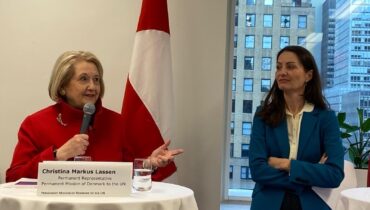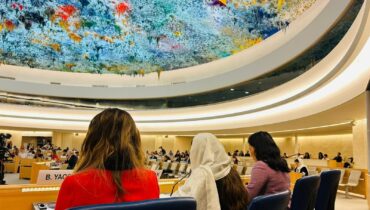Vice President Kamala Harris recently announced a “national emergency:” the 2.5 million women who have left the work force since the beginning of the pandemic. “Our economy cannot fully recover unless women can participate fully,” the Vice President stated.
The pandemic has exposed gender inequities and, in the course of one year, rolled back decades of progress for women and girls in the United States and around the world. Before taking office, President Joe Biden released his Agenda for Women as a function of building back better after the COVID-19 pandemic. The agenda aims to stem the roll-backs of women’s rights that have resulted from the pandemic, as well as ensure that women are put on equal footing with their male counterparts. With that goal in mind, the Biden Administration released its National Strategy for the COVID-19 Response and Pandemic Preparedness (“National Strategy”), which, among other things, commits to addressing the worsened global gender inequalities caused by the pandemic. It recognizes that “the pandemic has . . . disproportionately affected women and girls and significantly deepened existing gender inequalities around the world.” (107)
Here, we examine the global emergency for women caused by Covid-19 and analyze how the Biden Administration’s National Strategy can most effectively center women and girls and address intersectionality.
Increased Inequalities and Violence Against Women
COVID-19 has reversed the limited progress that has been made on gender equality and women’s rights. Gender-based violence—which is recognized to include child marriage and other forms of customary practices—has increased during COVID-19. We applaud the National Strategy and call upon this administration to continue to look at gender-based violence more broadly to include the uptick in child marriage, female genital mutilation (FGM), and other forms of customary practices that subordinate women. For example, the number of girls subjected to FGM is believed to have gone up due to the COVID-19 pandemic. UNICEF estimates that coronavirus-related school closures and disruptions to aid programs mean that two million more girls are now at risk of being subject to FGM before the end of the decade, bringing the total number to 70 million.
The global pandemic has also resulted in lockdowns and school closures around the world, exacerbating customary practices which subordinate women. For example, the pandemic has resulted in an increase in child marriage globally. In fact, the pandemic is estimated to result in 13 million more girls forced into early marriages between 2020 and 2030. In many countries, including, Ethiopia, Kenya, Malawi, and Nepal, there is data on an uptick in forced marriage.
COVID-19-related school closures have interrupted the education of approximately 1.6 billion children worldwide. Evidence from the 2013 Ebola outbreak shows that the probability of returning to school greatly diminishes the longer girls are kept out. Also, one million more girls risk becoming pregnant due to the lockdown measures and disrupted access to reproductive health centers and services. To avoid the stigma associated with out-of-wedlock pregnancies, families may be more inclined to marry their underage daughters. Furthermore, the economic strain caused by the recession on already vulnerable communities and the loss of family income is an additional incentive for families to marry off their school-age girls, perceiving them as financial burdens and resulting in a lost generation of young women.
Nearly sixty percent of women around the world work in the informal economy, and Covid-19 is increasing the feminization of poverty. In the Unites States, women, and particularly Black women and women of color, have been the most negatively impacted by the pandemic, which has laid bare the gaping gender and intersectional inequalities. For example, in September, 865,000 women left the United States workforce, which is four times more than men, and in December, employers laid off 140,000 jobs, all of which were held by women.
There is a correlation between economic insecurity and violence against women that must be brought to the forefront. In response to the crisis, some countries have adopted new legislation in recent months. Lebanon adopted a new sexual harassment law and Sierra Leone rolled back a law that disallowed pregnant girls from attending schools.
Centering Women & Girls Globally
The National Strategy is organized around seven goals. For the purposes of the post, we will examine only the seventh goal, which seeks to restore the United States’ leadership globally (21-23). In addition to re-engaging with the World Health Organization, the National Strategy’s seventh goal commits to “surg[ing] the international COVID-19 public health and humanitarian response” (110). In order to fulfill that commitment, the National Strategy states that the United States will “enhance humanitarian relief and support for the capacity of the most vulnerable communities to prevent, detect, respond to, mitigate, and recover from impacts of COVID-19, such as. . . gender-based violence.” (111).
The National Strategy does more than just promise to support international humanitarian relief and resilience efforts – it also commits to “engag[ing] women and other vulnerable groups as part of these efforts” (111). Furthermore, it pledges a multilateral agenda, with the bedrock of the agenda being gender: “The Administration will…act on the UN Secretary General’s call to put women and girls at the center of global recovery efforts” (114).
Similarly, the 2020 December United States stimulus bill makes significant funds available to Afghanistan and Pakistan for the purpose of including women in important conversations about these countries’ futures, and significantly increases the recruitment, training, and retention of women in judiciary, police, and other security forces to address and prevent gender-based violence.
Ensuring that women and other vulnerable groups are part of the solution is a non-negotiable move by the Biden Administration: it is impossible to effect change to its greatest potential without consulting those who will be most impacted by the efforts. Women and other vulnerable groups are among the most impacted during the pandemic and are living the secondary impacts. They will provide invaluable insight into what needs to change and how. While the National Strategy recognizes the importance of centering women, more must be done to implement the decisionmaking of women worldwide in a global recovery.
Acknowledging the Importance of Intersectionality
The National Strategy also recognizes that gender is only one axis of difference that often intersects with race, ethnicity, ability, and indigenous identity (183). It acknowledges that the pandemic “exposed and exacerbated severe and pervasive health inequities among communities defined by race, ethnicity, geography, disability, sexual orientation, gender identity, and other factors” (19). The intersectional identity includes not only race but geography, disability, and sexual orientation: “The pandemic is reversing hard-fought gains in global health, including routine immunizations, maternal and child health, and the fight against tuberculosis, malaria, and HIV/AIDS, and is increasing the risk of gender-based violence” (107).
The National Strategy commits to “[r]educing racial and ethnic disparities in COVID-19 global response and disproportionate impacts on marginalized and indigenous communities, women and girls, and other groups” (114). It also vows to “take steps to enhance humanitarian relief and support for the capacity of the most vulnerable communities to prevent, detect, respond to, mitigate, and recover from impacts of COVID-19, such as food insecurity and gender-based violence” (20).
This same approach to intersectionality nationally must be mainstreamed into foreign policy and development cooperation in accelerating global recovery plans. The recovery plan provides a moment of opportunity to build a better architecture to restore the rights of women at the margins, including: ethnic minorities, indigenous women, refugee populations, displaced populations, and LGBTQ women.
To be successful, the National Strategy, which is built on multilateral development cooperation and a global recovery plan that makes gender central, must ensure a sensitivity to context and the needs on the ground. If the reset does not see women on the ground leading decisions that will engage them fully in a global recovery economy, we are heading toward a global emergency.
Ambassador Melanne Verveer is the Executive Director of the Georgetown Institute for Women, Peace and Security and the first US Ambassador for Global Women’s Issues.
Rangita de Silva de Alwis is faculty at the University of Pennsylvania Law School and Hillary Rodham Clinton Fellow on Gender Equity at Georgetown. She thanks Dean Theodore Ruger, Dean of the University of Pennsylvania Law School for his support.


